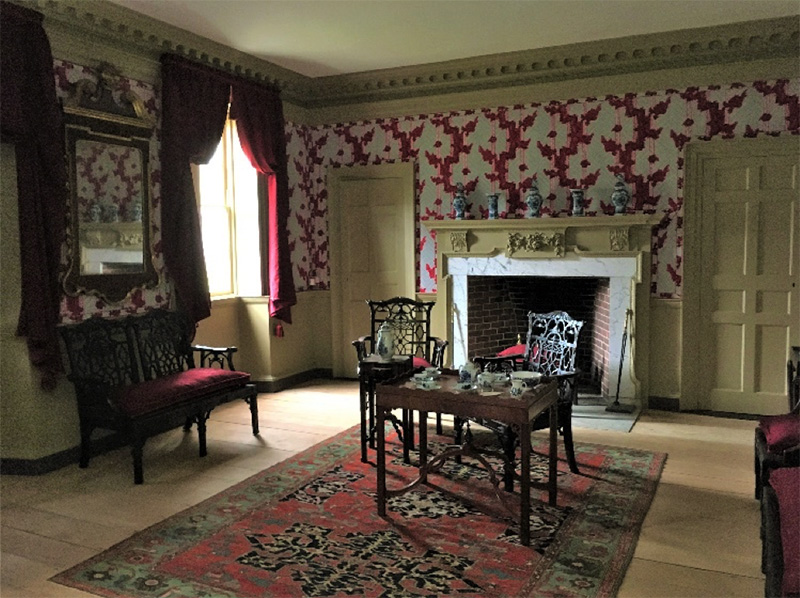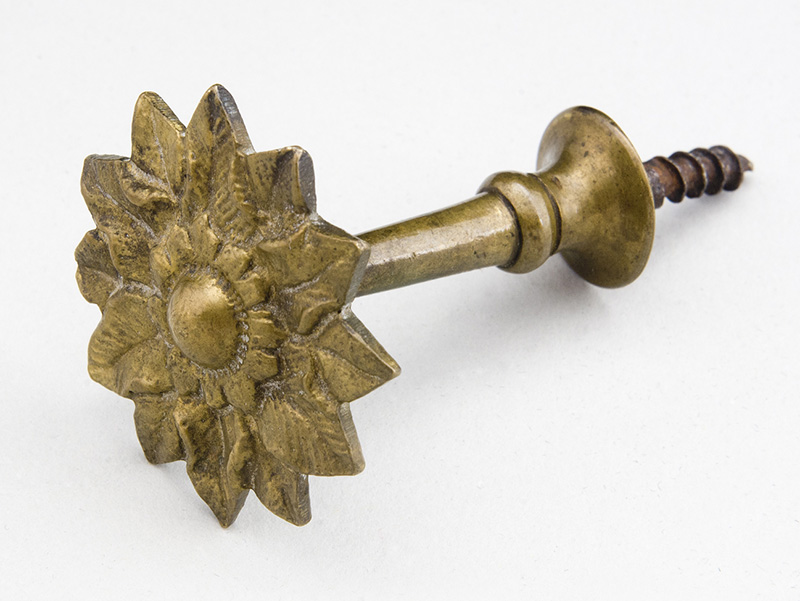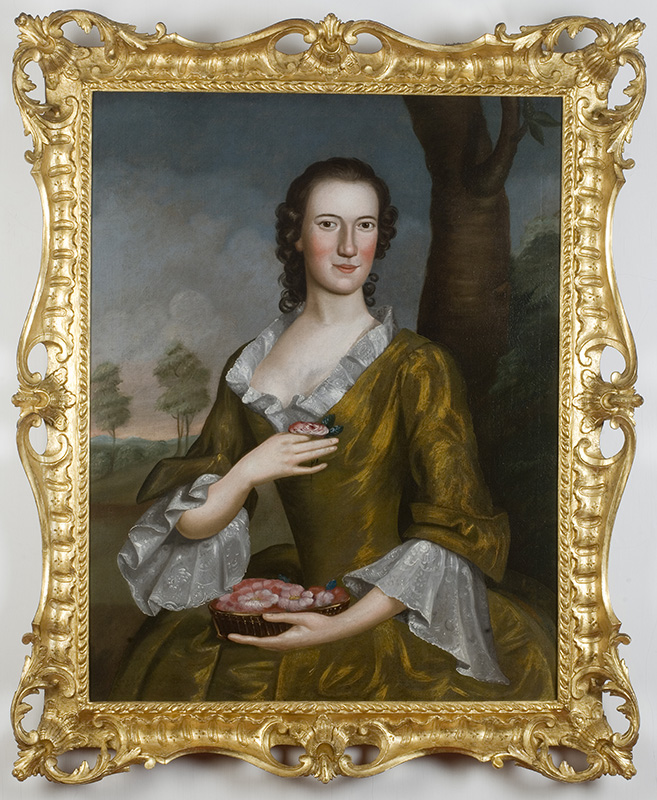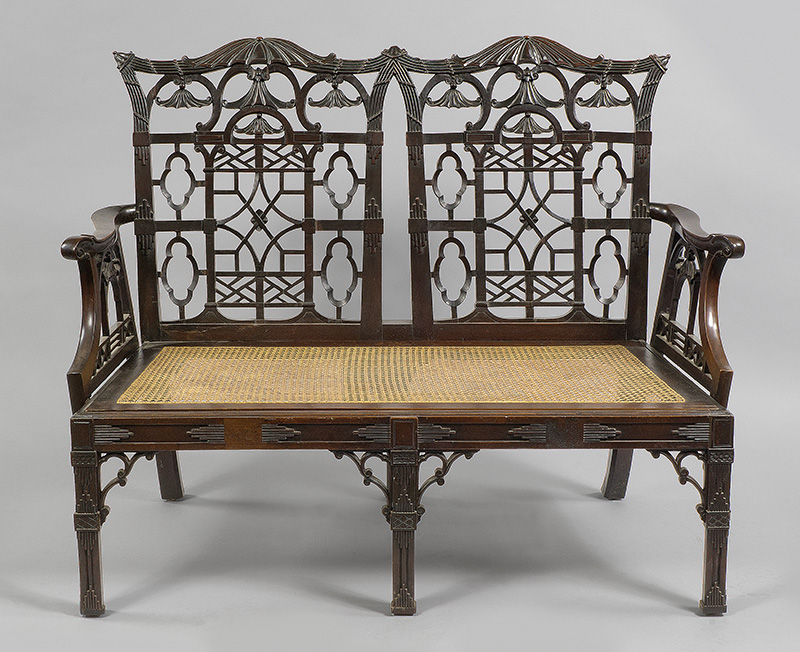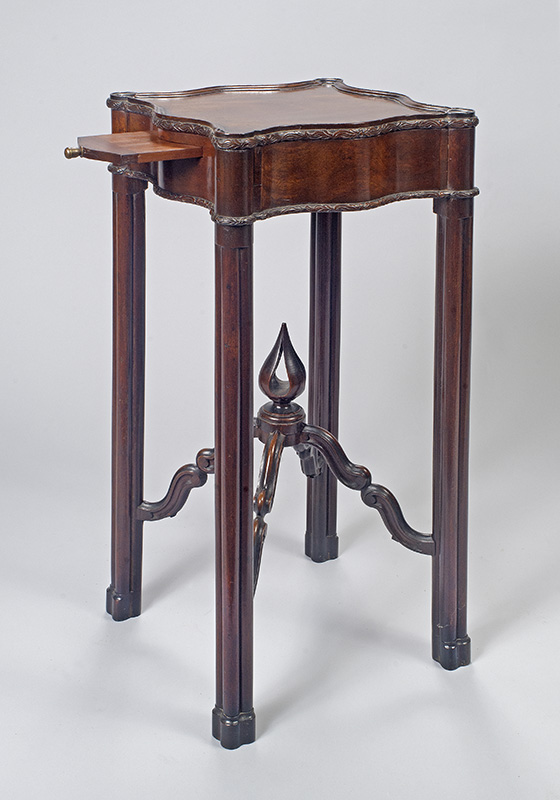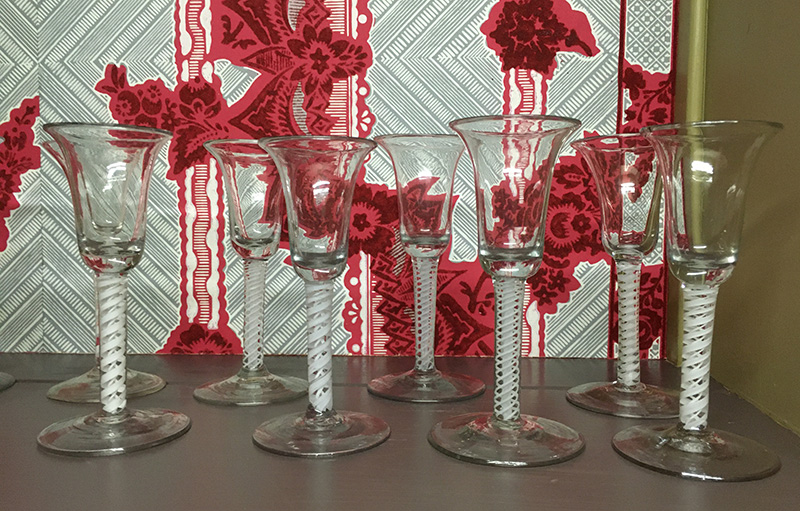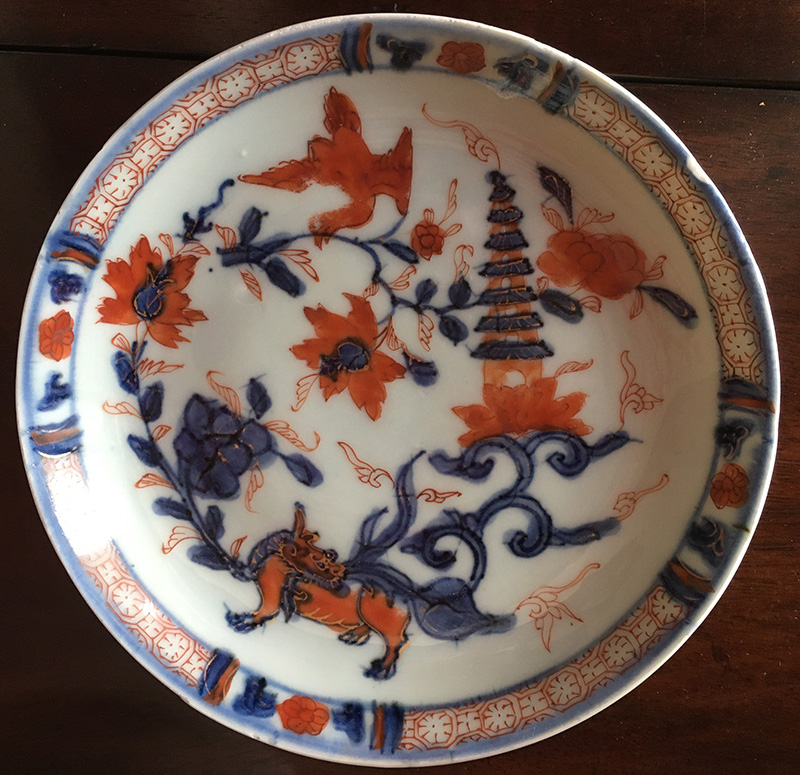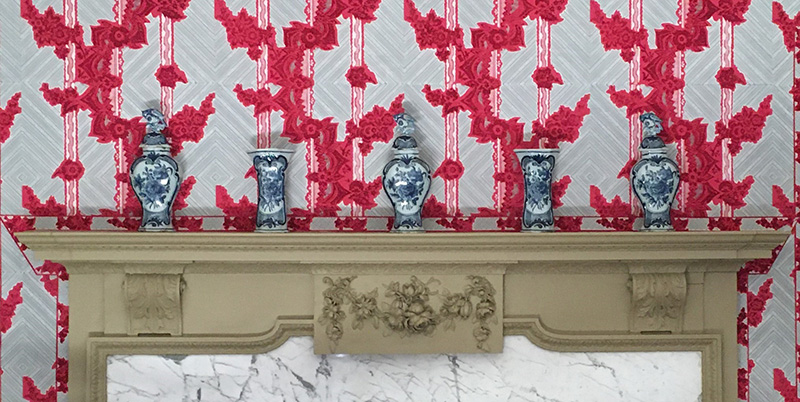An 18th-Century Parlor Brought to Life: The Artful Restoration of New Hampshire’s Moffatt-Ladd House
by Barbara M. Ward
For the past several years, a committee of staff and volunteers has been working on a renovation of the Parlor of the Moffatt-Ladd House (figures 1 and 2), built in 1761–63 in Portsmouth, NH. This project has encompassed every aspect of the room’s floor, wall, and window treatments, as well as a re-assessment of the room’s furnishings from the 1760s to early 1780s. This article focuses particularly on this last aspect of the project, which included augmenting the collection in significant ways to achieve the goal of returning the room to its appearance during the late 18th century.
From 1764–1768, the residence was home to one of Portsmouth’s most promising young merchants, Samuel Moffatt (1738–1780). From 1769–1786, following Samuel’s bankruptcy, the house was occupied by Samuel’s father, John Moffatt (1691–1786), who commissioned the house from Michael Whidden III and the interior woodwork from carver Ebenezer Deering and turner John Mills.
Samuel’s sister Katharine and her husband, William Whipple (1731–1785), also resided here between the time of their marriage in 1771 and his death. William was one of New Hampshire’s three signers of the Declaration of Independence, and the house was the location for many momentous events leading up to and during the American Revolution, including a dinner party attended by John Adams and Ezra Stiles. The significance of the Whipple’s occupancy, and the extensive late-18th-century documentation in the form of inventories and bills, led us to restore the Parlor to that era, even though the wainscoting was removed in the early 19th century and the windows were replaced at about the same time.
Although there were many aspects to the restoration involving repairs to the floor, ceiling, and woodwork, this article focuses on collecting for the Parlor, an effort aided immeasurably by the existence of several inventories taken in the period for various estate and auction purposes. These documents, once collated, compared, and interpreted, have provided a shopping list for the acquisition of objects—especially glass and ceramics—that bring the inventories to life. Reproduction items were acquired when necessary to further the interpretation, and reproduction wallpaper and textiles were commissioned as key components to realize our vision.
When the house reopens next year, visitors will be immediately struck by the bold red, pink, gray, and white flocked wallpaper, reproduced by Adelphi Paper Hangings from surviving wallpaper in the Billiard Room of the Wentworth-Coolidge Mansion, in Portsmouth. Wallpaper expert Richard Nylander, one of the members of our Parlor Restoration Committee, suggested this paper as our model for several reasons. Fashionable in the Piscataqua River area of New Hampshire and Maine, flocked wallpaper of this type gave the room a sophistication shared by other homes owned by the area’s elite merchants and government officials, including the c. 1760 house built for John Wentworth, the colony’s last Royal Governor.
In December of 2017, we discovered fragments of wallpaper in the west closet of the room. This closet originally had a window and shelves, suggesting that the space was used as a small pantry. The wallpaper was described in a family letter as “heavy velvet paper with red lines,” conclusively linking the fragments we found in the closet to the paper that was used on the walls of the room. This conclusion gained further credence when we realized that the closet directly above, which also originally had a window, was papered with the same wallpaper that was used on the walls of the adjacent room. Unfortunately, the fragments of paper found in the Parlor closet were insufficient to reconstruct the whole design. After much deliberation and a great deal of research and outreach by Nylander, the committee decided that the best match in color, design, and provenance to these fragments was the original paper still surviving (albeit in much deteriorated condition) at the Wentworth-Coolidge Mansion in Portsmouth.
Three reproduction window curtains in red wool camblet and matching furniture cushions provide a colorful and cohesive setting (figure 1). The fabric was woven and embossed by Kate Smith and Justin Squizzero of Eaton Hill Textile Works. Natalie Larson of Historic Textiles, Inc., and committee member Jane Nylander worked together on the design, and Larson made the curtains and seat cushions. The tassels were procured from Passementerie Inc. The design of the curtains was determined by close examination of the physical evidence for the location of the cloak pins used for securing the cords for the curtains. This evidence, along with the lack of any indication of wooden cornices over the windows, suggested that the original window coverings were “drapery curtains.” Their swagged shape was created by drawing up the fabric with cords that were then wrapped around pairs of cloak pins at either side of the window frame.
We were delighted to discover an 18th-century cloak pin in the Moffatt-Ladd attic, which was then reproduced by the Hobart Foundry (figure 3). The pin closely resembles engravings in two English brass founders trade catalogues of c. 1775 and c. 1780. Samuel Moffatt’s inventory and two advertisements of his wares demonstrate that he imported a large variety of hardware for sale in his store.
The various inventories also specify a number of “Persia carpets” in varying sizes located throughout the house. One of these appears in the 1786 inventory in the Back Parlor as a “Carpet” valued at £6. We concluded that this was the same as the “14/4 Persia Carpett” that appears in the 1768 bankruptcy listing and in the bankruptcy sale record in the Front Parlor. Our committee elected to acquire a high-quality reproduction Star Oushak carpet (figures 1 and 2) from Woven Legends that matches the period description. The carpet blends well with the striking colors of the room’s wallpaper and textiles.
Paint analysis and physical evidence found during our renovations led to the conclusion that the floor was unpainted, matching many of the interiors portrayed in mid-18th-century English family portraits. The woodwork and trim throughout the room was updated based on a fresh look at the paint history.
Fortunately, the Moffatt-Ladd collection already contained important and appropriate furnishings around which to build the reinterpretation. The four Moffatt family portraits by the artist John Greenwood (1727–1792) (figures 2, 4, and 5) and seven pieces from a set of London-made Rococo furniture (figures 1, 2, and 6) provided the backbone for the reinstallation plan. The latter were inherited by Maria Haven Ladd in the 1840s while living in the house and suggest 18th-century Portsmouth’s taste for Chinoiserie design. As now displayed, the room represents the best that the city had to offer.
A 1760s kettle stand given to the Moffatt-Ladd House a few years ago is another highlight (figure 7). Attributed to Robert Harrold of Portsmouth, the stand was made en suite with a tea table now in the collection of the Warner House Association, which has graciously agreed to a loan for the renovated room’s inauguration. A reproduction tea table by the contemporary cabinetmaker Allan Breed will be on view to represent the “rail[e]d tea table” listed in William Whipple’s 1786 inventory (figures 1 and 2).
Glass
The inventories include an impressive amount of table glassware, all presumably imported from England. Both quantities and types are enumerated. The 1768 court inventory specifies 159 pieces of glass tableware, including 3 glass salvers and 156 glasses of 5 different types. Collecting this quantity of mid-18th-century glass was not feasible. We have been able, however, to acquire several period wine glasses (figure 8) that hint at the depth of the Moffatts’ holdings. We were also able to borrow a c. 1750 wine glass from the Portsmouth Historical Society and to make use of some carefully selected reproductions. Most of the glassware is displayed in the West Closet adjacent to the mantel. The display of glassware and ceramics in the west closet pantry allowed us to underline the role of the enslaved members of the household who used this small space in serving the family and their guests. This wide variety of imported objects also provided the opportunity to interpret the importance of British and European goods in American households.
Ceramics
The various Moffatt inventories and lists are unusually specific in their discussion of the ceramics used in the house. This degree of precision guided our collecting of imported English and Asian ceramics. For example, one inventory includes “1 Sett Pencill’d English China Cups & Saucers” in the Back Parlor. The compiler likely intended to distinguish the Moffatts’ wares from the more common Chinese version of so-called pencil ware. These wares were produced by the Worcester Porcelain Manufactory during the Warmstry House period, 1755–1756. This listing allowed for the purchase of English cups and saucers in the “Boy with Buffalo boy” pattern (figure 9), one of the earliest patterns produced by this factory, as well as a rare teapot to accompany them. The brown-black drawings on these objects are related to a Chinese technique called encre du chine (ink of China), and they appear as if they are engraved.
“Burnt China” also appears in the various inventories, referring to cups and saucers and two large bowls. With the help of Amanda Lange at Historic Deerfield, these references have been interpreted to mean a type of Chinese Imari ware featuring designs in orange, red, blue, and other colors. While the collection already contained some burnt china plates (figure 10), we were able to acquire a set of eight cups and saucers and a bowl to match the descriptions.
There are also references to “Blue China” in the inventories, including a bowl, plates, and cups and saucers, which we interpret as imported Worcester wares of the period. Several examples already in the collection were augmented by a gift from Jane Nylander, the purchase of a coffeepot, sugar bowl, creamer, and other wares (figure 11), and the loan of a cup and saucer from the Portsmouth Historical Society.
Although a garniture is not specifically identified in any of the existing documents, the mantel shelf in the Parlor seemed to require this element, as often seen in English paintings and prints of the mid-18th century. Thus, we acquired a five-piece Dutch Delft set (figure 12) to grace the mantel and provide a strong color contrast with the red flocked wallpaper.
While progress has been made, we still seek specimens to match the inventory reference to “4 Marble China Bowls & Saucers,” likely a Whieldon-type ware, more glassware, and “China” forms referenced in the inventories that are difficult to link precisely with surviving objects.
We hope that the newly restored Parlor at the Moffatt-Ladd House will give visitors a vivid picture of the seductive English goods and lavish lifestyle that Revolutionary firebrands like Whipple eschewed in pursuit of the Patriot cause.
Barbara M. Ward is the Director/Curator at the Moffatt-Ladd House and Garden, a National Historic Landmark owned and operated by the National Society of The Colonial Dames of America in the State of New Hampshire. The author thanks curatorial assistant Stephanie Rohwer-Hewson and the members of the Parlor Committee—Jennifer Evans, Cheryl Cullimore, Meredith Harding, Jane C. Nylander, Richard Nylander, Mary Waples, Barbara M. Ward, Gerald W.R. Ward, and Mary P. Waples—who made incredible contributions to the project. The committee is indebted to Amanda Lange of Historic Deerfield for sharing her expertise and offering guidance to us in the acquisition of ceramics and glass for the collection. The group also acknowledges the assistance of the State of New Hampshire, which owns and operates the Wentworth Coolidge Mansion, for its support and partnership in the reproduction of the wallpaper.
A print version of this article was published in The Magazine of the Decorative Arts Trust, one of our most popular member benefits. Join today!

